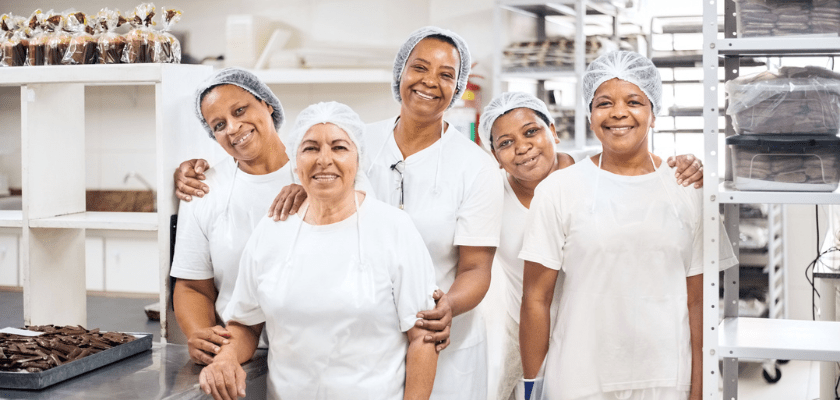Root causes, real solutions: Uncovering safety risks in Ontario food manufacturing

It only takes a second for an unguarded machine to catch a worker and cause a critical injury. Or for a worker to be hit by a forklift. It takes even less for energized equipment to crush a worker when they expect it to be locked out. Unfortunately, these are not hypothetical situations. They represent the lives of workers in Ontario’s food manufacturing industry who had a routine day turn into a nightmare.
Food manufacturing is considered a high-risk sector due to elevated lost time injury (LTI) rates compared to other sectors and the high number of vulnerable workers. For workers in this sector, proper training, established procedures, and a positive health and safety culture that encourages workers to speak up can be the difference between life and death.
Since worker and management representatives from Ontario’s food manufacturing industry participated in a risk assessment workshop in 2022, experts from Workplace Safety & Prevention Services (WSPS) have been working closely with the industry to mitigate the top risks and foster work environments where everyone returns home safely at the end of their shift. “A big part of risk mitigation is understanding the risks as well as the root causes,” says Rishma Brenner, Senior Health and Safety Consultant with WSPS. “WSPS has used the information and insights from industry representatives to drive solution development.”
Uncovering root causes
Rishma has been involved in the risk assessment and root-cause analysis process from the start and has seen the positive impact a group of dedicated people can have on an industry. Introduced by the Ministry of Labour, Immigration, Training, and Skills Development (MLITSD) several years ago, this methodology is industry-driven and results-oriented. Worker and management representatives identify the top risks facing employees in a one-day workshop. For food manufacturing, the top risk was the inadequate lockout/tag out of equipment.
After the primary root causes for inadequate lockout/tagout were uncovered, the next step was to delve into the root causes of two more hazards. “Using fishbone diagrams, we looked at the root causes for mobile equipment incidents, as well as bypassing safeguarding on equipment. Both risks were high on the top ten list compiled by the industry representatives,” explains Rishma.
“After working through these two additional hazards, we went back to the industry to validate and rank the root causes that were identified,” she says. Once the primary root causes were clear, it was time to focus on targeted solutions. “Once again, we worked with industry representatives to brainstorm solutions. It is important to listen to the people who are experiencing these hazards on a day-to-day basis to ensure that we are developing tools they can practically use. We asked what would help them, and they told us.”
Engaging in high-risk needs assessments
A tailored service developed as a direct result of this risk assessment and root-cause analysis was a High-Risk Needs Assessment (HRNA). Betty Lofthouse, Senior Health and Safety Consultant with WSPS, and her colleagues have completed an HRNA with 52 food manufacturing firms.
“With the top hazards and primary causal factors identified, we crafted a needs assessment that we took to food manufacturers,” explains Betty. “The needs assessment questions are driven by the primary causal factors, and outcomes are mapped to specific WSPS solutions. We are helping these workplaces pinpoint gaps, understand needs, and initiate the implementation of practical solutions. All at no cost to them.”
A high-risk needs assessment usually begins with the consultant completing a review of the firm’s related health and safety documentation before they arrive on site. The next step is a tour of the site. “It’s not an inspection, but rather an opportunity for us to observe conditions and practices,” says Betty. Conversations and interactions with employees are part of the process as well. “We engage with production people, safety people, and supervisors,” says Betty.
Once the HRNA is complete, the company is given a report with an action plan to address the specific issues that were identified at their workplace. Then, the company receives 21 hours of prepaid consulting services from WSPS to help them initiate that action plan. “The goal of all of this is to move the needle with respect to injury and illness prevention in Ontario workplaces,” says Betty.
Building on this successful approach, High-Risk Needs Assessments are now being offered to all food and beverage manufacturers in Ontario at no cost. This expansion ensures that every business in the sector, regardless of size, can request this assessment. Each assessment includes a half-day on-site visit from a WSPS consultant with a focus on the top three risks. A tailored action plan will be provided, highlighting priority areas for improvement with access to WSPS resources that support continued progress.
“This is a great opportunity for food and beverage manufacturers to strengthen workplace safety, improve compliance and support a safer sector with expert advice and actionable recommendations,” Betty adds. “To participate, simply contact your account representative or reach out through WSPS Customer Care.”
Seeing solutions in action
Birva Yashkumar Dave is the Environmental Health and Safety Manager at Snackruptors Inc. (formerly RDJ Bakery). She understood the value of getting involved with this initiative from the beginning. “When we decided to participate, we were primarily aiming to enhance our health and safety practices, especially for our workers. It was a launchpad for further action,” says Birva. “The top risks identified align closely with the challenges we face in our workplace. Using the resources provided by WSPS, we’ve been able to mitigate these risks more effectively, particularly focusing on things like proper safeguarding of equipment.”
Birva led Snackruptors through the HRNA with a WSPS health and safety consultant. “The results of the needs assessment were incredibly informative, providing us with a clear roadmap of areas where we needed to improve,” says Birva. One of the key points highlighted in their report was the need to enhance their procedure for Control of Hazardous Energies, which they are currently working on improving. “The consultant’s recommendations were practical and actionable. They were invaluable in helping us create more structured and effective safety protocols.”
Snackruptors is leveraging several of the targeted resources that WSPS has developed to help food manufacturers address specific hazards. “We have used these resources in our workplace to enhance hazard controls, implement more focused risk management strategies, and ensure we follow best practices,” says Birva.
Leveraging industry-specific and hazard-specific resources
In addition to the HRNAs and prepaid customized consulting, WSPS created several new resources to assist companies as they implement their action plans. “These solutions came out of root-cause analyses and were created with the advice and guidance of industry representatives. They are truly industry-driven,” says Rishma.
Lockout Tagout resources:
Downloadable infographics:
- Top 6 Root Causes of Mobile Equipment Incidents and Inadequate Safeguarding in Food Manufacturing
- Mechanical Safeguarding Poster: MAC & AUTO
Tools to help you understand pre-start health and safety reviews (PSRs):
Guidance documents to help select safety technologies:
- Mobile Equipment and Pedestrian Safety Technologies Guide
- Effective Safeguarding: Best Practices and Insights
Along with toolkits and resources, the free High-Risk Needs Assessment service provides companies with the opportunity to address unique site challenges through dedicated, expert support.
High-Risk Needs Assessments now represent a cornerstone of proactive safety culture for Ontario's food and beverage manufacturing sector. By providing access to health and safety expertise, customized action plans, and practical resources at no cost, these assessments can help businesses of every size strengthen compliance, prevent workplace injuries, and build long-term operational resilience. Together, these efforts are helping to shape an industry that is safer, more resilient and better equipped to tackle its most pressing health and safety issues.
The information in this article is accurate as of its publication date.




